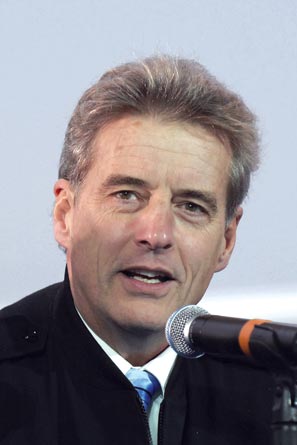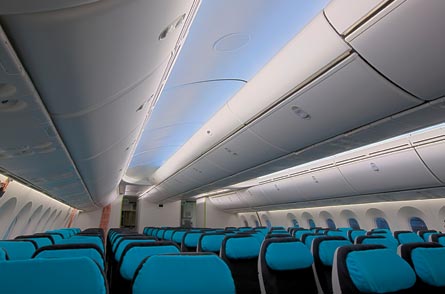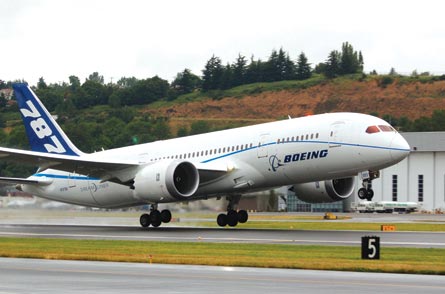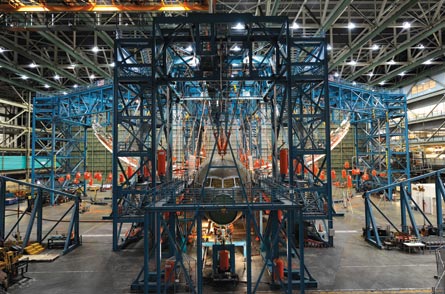The long and arduous road that Boeing has trod to get the 787 into its flight-test campaign has given way to a swift accumulation of accomplishments for the new long-range twinjet, although the path to year-end certification is marked by a need to steadily accumulate test hours and some of the most challenging flying yet.
Since its 15 December 2009 maiden sortie, with captains Mike Carriker and Randy Neville at the controls, Boeing has flown five test aircraft, crossing the 1,000h mark on 16 June, which include all four Rolls-Royce Trent 1000-powered 787s and the first of two GEnx-1B64 powered aircraft.
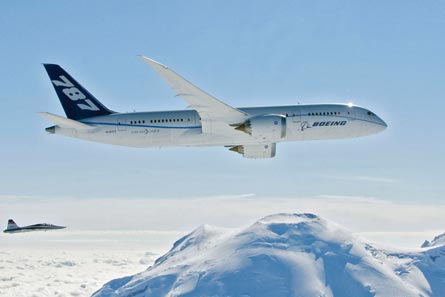
While Boeing concedes it was slow in ramping up its initial flight-test hours in the early months of the flight-test campaign, which is expected to accumulate a total 2,430h and 670h of flight-testing split between Rolls-Royce and General Electric-powered test aircraft respectively, the pace of collecting hours has accelerated as the company exploits a 24h methodology.This has the aircraft testing over two blocks during the day, with a third for overnight maintenance and preparation for the day to follow.
The first Dreamliner, ZA001, which has accumulated the most flight test hours in the fleet, spent its first month flying undergoing initial airworthiness tests which included early stability and control testing and stalls to establish the control characteristic of the new jetliner, expanding the operating envelope to an initial altitude of 30,000ft (9,150m) and Mach 0.65.
|
|---|
Following initial airworthiness testing, ZA001 progressed through flutter from 14 February until 19 March during 28 test days and 104h, clearing the aircraft structure and allowing the aerodynamic configuration of the aircraft to be fully frozen. The testing also saw ZA001 achieve M0.97 in a dive and a maximum altitude of 43,100ft, clearing the top end of the aircraft's operating envelope.
"When it came time to do the flutter testing, there were 2,150 test conditions that we'd initially planned to do. We knocked that down to 1,350," says Pat Shanahan, vice-president of airplane programmes. "So we're taking tests out and we're completing the engineering ahead of schedule in some cases, so we have to fly less."
Scott Fancher, general manager and 787 programme vice-president, described the 787 halfway into its certification plan as "nearly flawless", with few squawks, or maintenance issues, cropping up. The most visible came on 21 February when a faulty sensor caused an unplanned roll back in power on ZA001's Trent 1000 engines, prompting a cautionary landing with one operable engine at Moses Lake, Washington.
From the completion of the 15 January initial airworthiness clearance through to late April, Boeing's focus was on achieving expanded type inspection authorisation (TIA) from the US Federal Aviation Administration, which marks the formal kick-off of the certification effort, at which point regulators are invited on board to participate in testing.
Leading up to this point, Boeing prepared to present the 787 fleet to regulators as design-conforming test articles, incorporating the latest package of changes realised during flight testing.
"Every change that we've had to go address we've been able to correct within a week," says Shanahan, who adds that structurally there were no major changes to the aircraft, just minor box changes and software changes. "They'll do wiring changes but nothing significant," he says.
Following stall testing, the test fleet underwent modifications to the slat system to bolster positive pitch recovery under certain conditions. The adjustment, which was first introduced with a software change, was made permanent with a mechanical modification. Mike Carriker, chief project pilot, says jokingly that the Dreamliner's stall characteristics put a widely flown single-engined piston aircraft "to shame" and describes the 787's stall performance as "sublime".
In advance of TIA, ZA004, which made its first flight on 24 February, served as a software testbed for the latest version of the "wedge" 5.5 flight-control module software that began with regression ground testing on 11 March followed by flight-testing the new software on the second sortie on 18 March.
|
|---|
HITTING THE ROAD
The 787 left Washington state for the first time on 9 March with its arrival at Southern California Logistics airport in Victorville. The visit, which lasted until 23 March, saw ZA002 undergo ground effects and crosswind testing to evaluate the handling of the aircraft at low altitudes and the performance of the high lift system to feed the findings into simulation models for pilot training.
ZA003, the last of the Trent-powered flight-test aircraft, joined the fleet on 14 March with a 3h 5min ferry flight to Boeing Field. The aircraft is outfitted with two sections of nine-abreast economy seating that sandwiches racks of instrumentation. The aircraft, which is bound for Farnborough, will have the least amount of flight time of the Trent 1000 787 fleet, and has focused considerable time on accumulating the 3,100h of ground testing, with the aim of validating the environmental control systems and cabin environment of the aircraft.
|
|---|
On 18 April, ZA003 made a cross-country flight from Boeing Field to Eglin AFB in Florida, site of the McKinley Climatic Chamber, a US Air Force temperature controlled hangar large enough to accommodate a Lockheed C-5 Galaxy.
While in Florida, the aircraft took part in the Cabin Air Compression & Temperature Control System (CACTS) test that would subject ZA003 to temperatures as low as -42°C (-45°F) and up to 46°C. The first round of cold soaking the aircraft began on 20 April in two phases, first dropping the temperature to -26°C before powering up the aircraft systems from ground power, activating the auxiliary power unit, then heating the aircraft with activation of the environmental control system, returning the cabin to a temperature between 21°C and 24°C.
The tests were repeated three more times at temperatures of -42°C, 32°C and 46°C, bringing the aircraft from extreme temperatures back to equilibrium of 21°C and 24°C.
In preparation for the hot and cold soak testing in Florida, the aircraft was instrumented with thermocouples and pressures transducers to precisely gauge the temperatures and pressure across the airframe.
While the tests were not for certification, Boeing used the time in the facility to validate customer requirements.
"We're validating exactly the same thing an airline would do if they had to park the airplane in these sorts of conditions," says Tom Sanderson, ZA003 test director. "This is the worse case at the hot and cold ends. You've parked overnight, you couldn't keep the airplane warm, the whole structure is now 45° below zero and you have to bring it back up to a flight condition."
ZA003 later ferried from Eglin to Lackland AFB in San Antonio, Texas on 28 April following the hot and cold soak tests to undergo thermal wheel well ground tests, with the aircraft returning to Boeing Field on 3 May.
|
|---|
FIRST TO FLY
The first commercial airline pilots had an opportunity to fly the 787 for the first time on 12 May when captains Masami Tsukamoto and Masayuki Ishii from All Nippon Airways flew ZA001 on what was described by Fancher as "by no means a benign flight".
The 2h 50min flight included seven take-offs and landings, engine-out approaches and go-arounds, steep turns and "a really great opportunity for two ANA pilots that have been associated with the transition here to fly the airplane and begin the process of getting familiar with the airplane", says Fancher.
The following day, on 13 May, Boeing conducted VMCG take-off testing at Moses Lake, Washington, to establish the minimum control ground speed of the aircraft.
"We had planned about two or three days [to do VMCG], which is where you go down the runway, you run the throttles up to the max stop at very specific speeds," says Carriker.
"And then we stomp on the rudder pedal and you control the airplane," he adds. "This is one of the fundamental tests you have to do before you start doing your take-off performance testing because it defines the minimum speed. And we had planned about three days to do that test and we did it in one day in 2h."
|
|---|
In mid-May, ZA001 underwent natural icing trials.
"We caught the last two cold fronts to come over the north-west," says Fancher, who adds that those tests accomplished all the natural icing test points for the handling characteristics and functionality of the ice-detection and ice-removal systems.
"We planned for about a week and change to do the natural icing test and got it done in about five days," says Carriker. "And the biggest reason was because our meteorology guys said go here and you'll get icing. Before, it was kind of a poke and hope. We'd just go dropping down the Canadian border and try to find icing. And due to the meteorology department we actually said, go there, you'll find ice. And we were 100% in leaving the Boeing Field and going and finding ice."
Later in the summer, Boeing will affix pre-moulded ice shapes to the leading edges of the 787s wings to "anchor the performance models", says Fancher.
On 18 May, ZA001 performed the T-2 handling qualities demonstration with six 777 line pilots; three representing the FAA, one from the European Aviation Safety Agency, one from the Japanese Civil Aviation Bureau, and one from Transport Canada. Boeing hopes to transition 777 rated pilots to the 787 in five days.
With a Boeing test pilot sitting in the right seat, the 777 pilots conducted various manoeuvres including touch-an-go landings, single-engined cutouts on take-off, single-engined missed approaches and single-engined approaches to a full stop landing.
T-2 represents the second of three phases that are part of developing the training for the 787 to formally validate the aircraft's handling commonality with the 777. The first stage, T-1, is a paper-based systems comparison, followed by the significantly more rigorous T-2 phase, while T-3 will validate the training courses and takes pilots through a final FAA check ride. More than 130 Boeing staff have participated in this internally, says Carriker.
Carriker says the pilots reported the aircraft flew "like a 777, and while some said it was either a bit higher, low or about the same on flare forces, they all landed it on the right speeds, on the numbers and on the centreline".
ELECTRIFYING RESULTS
A crucial and entirely inadvertent validation of the 787's aircraft systems and composite structure came in May when ZA001 encountered an unexpected and rare electrical storm off Puget Sound during a test flight that resulted in the aircraft's first strike.
"We saw absolutely no physical or functional effects on the airplane," says Fancher.
While composite material does not naturally conduct electricity as its metallic predecessor does, Boeing has laminated a thin copper mesh into the skin of the aircraft to act as a conductive path in the event of any lightning strikes.
Every aircraft type in a Boeing commercial programme has been struck by lightning during flight-testing.
While flight-test crews were not able to pinpoint the location because of a lack of external marks on ZA001, Fancher says flight-test instrumentation damaged in the right wing suggested that it was the location of the strike. Fancher points out that the flight-test instrumentation is not required to withstand a lightning strike.
The lightning strike itself did not count for any formal certification test point, although Fancher says: "We learned something about the robustness and reliability of the airplane."
THE SECOND HALF
Heading into the second half of Boeing's year-long flight-test campaign, testing will shift toward gaining extended twin-engined operations certification with functionality and reliability systems testing. ZA004 has remained in Victorville following an extended stay for "nautical air miles" performance testing to measure the fuel efficiency of the Trent 1000 engines, which included short stints to Phoenix-Mesa Gateway airport in Arizona for hot weather testing, as well as high-altitude runway performance in Colorado Springs, Colorado.
Additionally, ZA004 will undergo a flight loads survey to compare real world data gathered from instrumentation deeply embedded into the aircraft structure to computer models that will assist in the development of the 787-9.
ZA005 is also expected to undergo flutter trials of its own to validate the airframe engine combination, with those tests set to begin at the end of June.
Both ZA005 and ZA004 will travel to Glasgow, Montana for community noise evaluations, demonstrating the acoustic performance of the airframe.
ZA004 will also repeat nautical air miles testing later in the year when Rolls-Royce delivers its Package B Trent 1000, setting up a minor-engine certification and performance evaluation that is expected to bring the engine specific fuel consumption within 1% of the originally planned specification.
The first flight of the last of six flight-test aircraft, ZA006, and the second powered by GEnx-1B engines, is set for early August and will contain a minimal data system to assist with electromagnetic effects testing, as well as ETOPS and systems functionality and reliability testing.
Additionally, Fancher says Airplane Nine, the third for All Nippon Airways, will be the first production 787 to fly, as it is scheduled to perform "a handful" of additional certification tests that are centred around differences between the flight-test and production aircraft.
The second half of the year is also expected to bring the two remaining "high-risk" manoeuvres, including velocity minimum unstick (VMU) take-off tests that will see ZA001 drag its tail along the runway.
The second, and potentially the riskiest manoeuvre, is the maximum brake energy, which will require ZA001's brakes to be milled down to beyond minimums.
"We intentionally go destroy the airplane," says Carriker, who says five flights will then follow to wear them down further.
"Then we load the airplane up, max gross weight, take a lot of concrete, a lot of steel on the airplane. You go whipping down the runway at a very deterministic speed. You pull the throttles idle and you dynamite the brake pedals and let the engine let the system get figured out."
The goal is to wait 5min or taxi 4.8km (3 miles) to prove no detriment to the aircraft exists, followed by fire crews extinguishing the destroyed tires and carbon brakes.
"All we really do that is try to save the axles for another day," says Carriker. "And it's really cool."
ABUSED AND TORTURED
In support of the certification campaign are two 787 airframes that will never take to the skies after being abused and tortured in a series of ground tests meant to validate the structure of the aircraft.
The first, a static test airframe, designated ZY997, is locked inside Building 40-23 of the company's Everett facility three American football field-sized doors from the final assembly line. The airframe, which initially revealed the weakness in the side-of-body during a May 2009 test, later validated the fix on 30 November with the limit load test that saw an upward wing flex of 5.5m (18ft), completing the analysis 10 days later and making way for ZA001's 15 December maiden flight.
On 8 February, Boeing completed internal authorisations to proceed to the 787's next crucial structural test that would see loads of 150% applied to the wings - more than an aircraft would ever experience in service.
The test, which took place on 28 March, saw the airframe pressurised to 1.5 times the normal operating pressure, followed by the upbending of the composite wings to a deflection of 7.6m with the assistance of 182 hydraulic actuators and counterbalance weights.
This test was intended to certificate the design of the wing and the side-of-body join. A second wing upbending test, this time with the fuselage unpressurised, is designed to test the loads on the fuselage.
General manager and programme vice-president Scott Fancher says Boeing is working with the US Federal Aviation Administration to determine if that final static test condition is required, and believes that enough data has been collected already with the existing tests to not require the final unpressurised configuration.
Additionally, Fancher says ZY997's wings will not be flexed upward to the point of failure, a long-debated issue that produced one of the most dramatic moments during the 777 programme as the aircraft's wings ruptured at 154% of limit load.
The data collected on the static test airframe will be applied directly to the design of the 787-9, which is set for its final configuration freeze at the conclusion of June following a three-day readiness meeting, says Fancher.
The second is the fatigue test airframe, ZY998, which moved from the factory to the outdoor test fixture on 31 January.
Preparations for the testing began immediately following the move from the factory to the text fixture and the fatigue testing that will see the aircraft accumulate two full service lives will begin "over the next couple of months", says Fancher.
Once the tests begin, Boeing plans to demonstrate 165,000 flight cycles over three years of fatigue testing the airframe, well beyond the 44,000 cycle design life of the aircraft and the certification target of 88,000 simulated take-offs and landings.
|
|---|
READ MORE
Challenges ahead for Boeing's 787
Source: Flight International





















